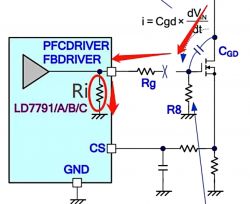Link
What is the function of the pull-down resistor on the of a MOSFET?

The pull-down resistor between the gate (G) and source (S) of a MOSFET serves several functions:
1.Preventing False Turn-On: The Miller capacitance, a parasitic capacitor between the gate (G) and drain (D), can cause the MOSFET’s drain-source voltage (Vds) to change from nearly 0 (saturation voltage drop) to the bus voltage when the MOSFET is turned off. This rate of voltage change is "dv/dt." Since a capacitor responds to voltage changes by generating a current, the voltage change across the capacitor generates a current "i."

The gate-source (G-S) junction has an insulating layer, usually silicon dioxide (SiO2), making G-S a high-impedance path (tens to hundreds of megaohms). If there is a driving abnormality, the current through the Miller capacitance can charge the G-S junction. A small current through a high impedance can correspond to a high voltage, potentially charging the gate voltage above the threshold voltage "Vgs(th)," causing the MOSFET to turn on again, which is a dangerous situation.
2.Providing a Discharge Path: In a flyback power supply topology, the Miller capacitance current is discharged through a low-resistance path inside the driver chip, preventing the gate from being charged high enough to cause a false turn-on.

Here, we understand that there is already a discharge pull-down resistor inside the driver chip. However, if the gate resistor (Rg) is open-circuited or not connected for any reason, the external pull-down resistor (R8) can provide a discharge path for the Miller capacitance, keeping the G-S junction of the MOSFET at low impedance for a stable and safe state. This is a critical function of the pull-down resistor.


**3.Pre-Protection Resistor:** Another function of the pull-down resistor is as a pre-protection resistor. The G-S junction of a MOSFET is high-impedance, which is why it is sensitive to ESD. High voltage applied to the gate is not easily discharged and, over time, can damage the silicon dioxide layer between the G-S junction, leading to device failure.
Therefore, the pull-down resistor balances power consumption and effective discharge. Typically, for low to medium power supplies (0-500W), a resistor value of around 10K-20K is chosen, while for high-power supplies, 4.7K-10K is selected.
What is the function of the pull-down resistor on the of a MOSFET?

The pull-down resistor between the gate (G) and source (S) of a MOSFET serves several functions:
1.Preventing False Turn-On: The Miller capacitance, a parasitic capacitor between the gate (G) and drain (D), can cause the MOSFET’s drain-source voltage (Vds) to change from nearly 0 (saturation voltage drop) to the bus voltage when the MOSFET is turned off. This rate of voltage change is "dv/dt." Since a capacitor responds to voltage changes by generating a current, the voltage change across the capacitor generates a current "i."

The gate-source (G-S) junction has an insulating layer, usually silicon dioxide (SiO2), making G-S a high-impedance path (tens to hundreds of megaohms). If there is a driving abnormality, the current through the Miller capacitance can charge the G-S junction. A small current through a high impedance can correspond to a high voltage, potentially charging the gate voltage above the threshold voltage "Vgs(th)," causing the MOSFET to turn on again, which is a dangerous situation.
2.Providing a Discharge Path: In a flyback power supply topology, the Miller capacitance current is discharged through a low-resistance path inside the driver chip, preventing the gate from being charged high enough to cause a false turn-on.

Here, we understand that there is already a discharge pull-down resistor inside the driver chip. However, if the gate resistor (Rg) is open-circuited or not connected for any reason, the external pull-down resistor (R8) can provide a discharge path for the Miller capacitance, keeping the G-S junction of the MOSFET at low impedance for a stable and safe state. This is a critical function of the pull-down resistor.


**3.Pre-Protection Resistor:** Another function of the pull-down resistor is as a pre-protection resistor. The G-S junction of a MOSFET is high-impedance, which is why it is sensitive to ESD. High voltage applied to the gate is not easily discharged and, over time, can damage the silicon dioxide layer between the G-S junction, leading to device failure.
Therefore, the pull-down resistor balances power consumption and effective discharge. Typically, for low to medium power supplies (0-500W), a resistor value of around 10K-20K is chosen, while for high-power supplies, 4.7K-10K is selected.


